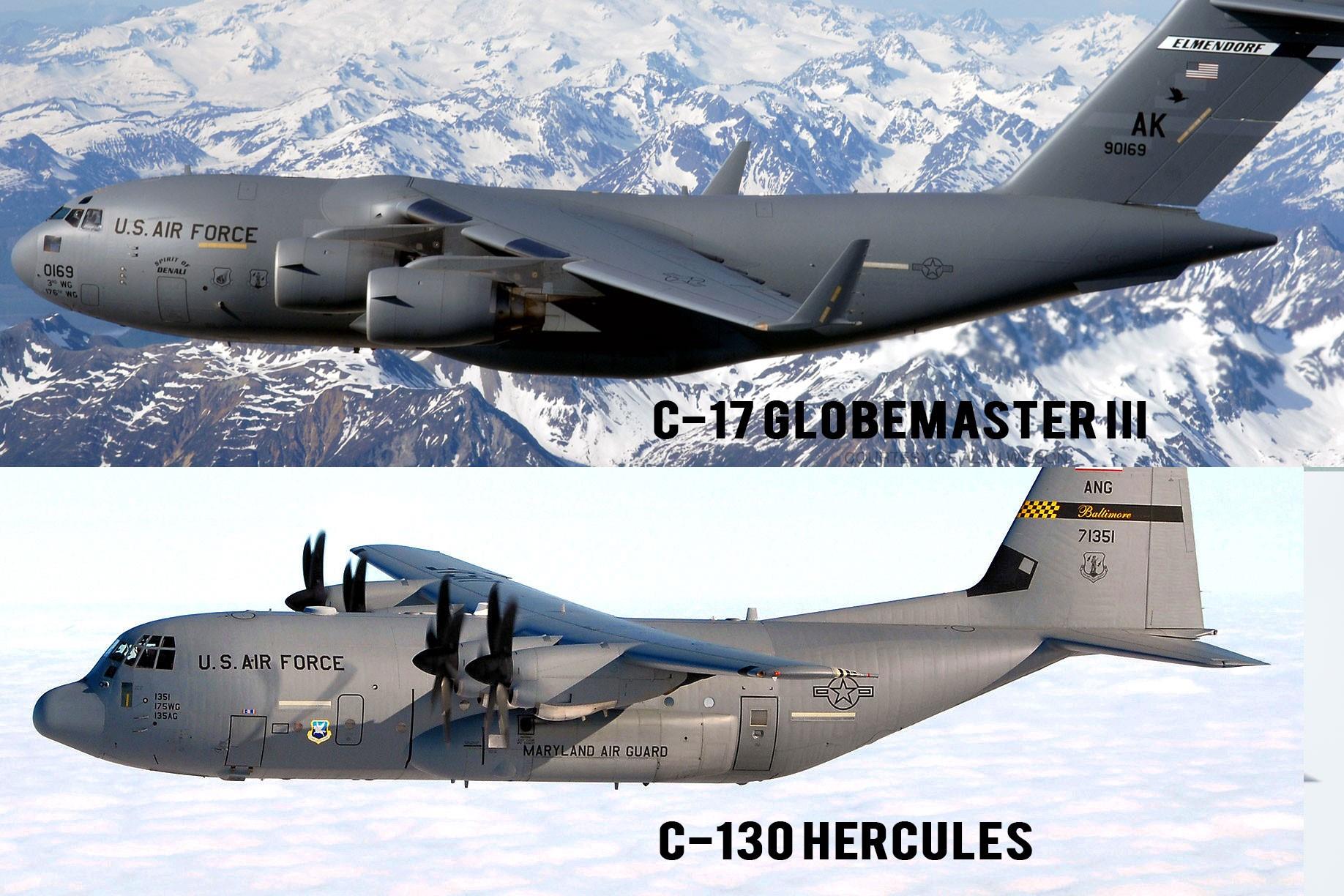Home>Technology and Computers>C-17 Vs C-130: Unveiling The Ultimate Giant Transport Aircraft!


Technology and Computers
C-17 Vs C-130: Unveiling The Ultimate Giant Transport Aircraft!
Published: January 19, 2024
Discover the ultimate giant transport aircraft showdown between the C-17 and C-130. Explore their technology and capabilities in this comprehensive comparison.
(Many of the links in this article redirect to a specific reviewed product. Your purchase of these products through affiliate links helps to generate commission for Noodls.com, at no extra cost. Learn more)
Table of Contents
Introduction
In the realm of military and humanitarian operations, the need for robust and versatile transport aircraft is paramount. Two stalwarts in this domain are the C-17 Globemaster III and the C-130 Hercules, both renowned for their exceptional capabilities. As we delve into the world of giant transport aircraft, we will uncover the distinctive features, historical significance, and operational prowess of these formidable machines.
The C-17 Globemaster III, developed by Boeing, stands as a testament to advanced engineering and innovation. This colossal aircraft has redefined the paradigm of strategic airlift, offering unparalleled performance and adaptability. On the other hand, the C-130 Hercules, with its enduring legacy, epitomizes resilience and steadfast service. Manufactured by Lockheed Martin, this venerable aircraft has withstood the test of time, consistently proving its mettle in diverse missions across the globe.
As we embark on this exploration, we will unravel the evolution of these aircraft, tracing their origins and pivotal milestones. Additionally, we will delve into their specifications, unveiling the intricacies of their design, power, and capabilities. Through a comprehensive performance comparison, we will gain insights into their distinct advantages and operational efficiencies. Furthermore, we will delve into their cargo capacities, shedding light on their pivotal role in transporting personnel, equipment, and supplies to remote and challenging terrains.
In essence, this comparative analysis aims to showcase the indomitable spirit and technological prowess embodied by the C-17 Globemaster III and the C-130 Hercules. By understanding their operational nuances and strategic significance, we can truly appreciate the monumental impact these giant transport aircraft have had on military and humanitarian endeavors. Join us on this exhilarating journey as we unravel the marvels of these aerial behemoths, illuminating their enduring legacy and unwavering contributions to global aviation and defense.
History of C-17
The genesis of the C-17 Globemaster III can be traced back to the late 1970s when the United States Air Force (USAF) recognized the critical need for a modern, high-capacity strategic airlift aircraft. In response to this imperative requirement, Boeing, a renowned aerospace company, embarked on a groundbreaking endeavor to develop an advanced transport aircraft that could surpass its predecessors in terms of payload capacity, range, and operational flexibility.
The developmental journey of the C-17 culminated in the maiden flight of the prototype on September 15, 1991, marking a significant milestone in the realm of military aviation. This monumental achievement underscored the culmination of years of meticulous design, rigorous testing, and technological innovation. Subsequently, the C-17 Globemaster III was officially introduced into service with the USAF in 1995, heralding a new era of strategic airlift capabilities.
The C-17's operational debut heralded a paradigm shift in the realm of aerial logistics and troop deployment. Its remarkable ability to airlift massive payloads, including combat vehicles, humanitarian aid, and personnel, swiftly garnered acclaim for its pivotal role in military operations and humanitarian missions. The aircraft's exceptional short takeoff and landing (STOL) capabilities further solidified its reputation as a game-changer in tactical airlift operations, enabling it to access austere airfields and remote locations with unparalleled agility.
Moreover, the C-17's technological prowess and adaptability have been underscored by its successful participation in a myriad of global operations, including humanitarian relief missions, peacekeeping endeavors, and strategic airlift operations. Its ability to swiftly transport troops and equipment to distant theaters of operation has cemented its status as an indispensable asset in the arsenal of modern military forces.
In essence, the history of the C-17 Globemaster III stands as a testament to the relentless pursuit of engineering excellence and operational supremacy. Its evolution from conceptualization to operational deployment has reshaped the landscape of strategic airlift capabilities, embodying the spirit of innovation and unwavering commitment to advancing the frontiers of military aviation.
History of C-130
The storied legacy of the C-130 Hercules is deeply entrenched in the annals of aviation history, embodying resilience, adaptability, and unwavering service since its inception. Conceived by the visionary engineers at Lockheed Martin, this iconic aircraft was conceptualized to meet the evolving needs of military transport and tactical airlift operations.
The genesis of the C-130 can be traced back to the early 1950s when the United States Air Force (USAF) sought a versatile and robust transport aircraft capable of fulfilling a myriad of missions, ranging from troop deployment to cargo transport in challenging terrains. In response to this imperative requirement, Lockheed Martin embarked on a groundbreaking endeavor to develop an aircraft that would redefine the parameters of tactical airlift capabilities.
The seminal moment in the history of the C-130 unfolded with its maiden flight on August 23, 1954, marking a pivotal milestone in the realm of military aviation. This inaugural flight underscored the culmination of rigorous design, engineering ingenuity, and relentless pursuit of excellence. Subsequently, the C-130 Hercules was officially inducted into service with the USAF in 1956, heralding a new era of tactical airlift operations.
The C-130's operational debut heralded a paradigm shift in the realm of military transport, as its unparalleled versatility and rugged design enabled it to excel in a diverse array of missions. Its ability to execute tactical landings on unprepared airstrips, transport troops and equipment, conduct aerial refueling, and facilitate humanitarian missions swiftly garnered acclaim, solidifying its reputation as a workhorse in the skies.
Moreover, the C-130 Hercules has etched its indelible mark on global aviation history through its enduring service in numerous military conflicts, peacekeeping endeavors, and humanitarian operations. Its ability to operate in austere environments, adverse weather conditions, and challenging terrains has rendered it indispensable in facilitating critical missions across the globe.
In essence, the history of the C-130 Hercules is a saga of unwavering dedication to operational excellence and steadfast service. Its evolution from conceptualization to operational deployment has redefined the contours of tactical airlift capabilities, exemplifying the epitome of resilience and adaptability in the realm of military aviation.
Specifications of C-17
The C-17 Globemaster III, a marvel of modern aviation engineering, boasts an impressive array of specifications that underscore its unparalleled capabilities as a strategic airlift aircraft. From its robust design to its exceptional performance metrics, the C-17 stands as a testament to technological innovation and operational excellence.
Dimensions:
The C-17's dimensions epitomize its colossal stature, with a length of approximately 174 feet and a wingspan extending to nearly 170 feet. This expansive footprint enables the aircraft to accommodate substantial payloads while retaining remarkable agility for tactical operations.
Payload Capacity:
One of the most remarkable features of the C-17 is its extraordinary payload capacity, capable of transporting a diverse range of cargo, including vehicles, heavy machinery, and humanitarian supplies. With a maximum payload of over 170,000 pounds, the C-17 redefines the parameters of strategic airlift, facilitating rapid deployment of essential resources to distant theaters of operation.
Powerplant:
The C-17 is propelled by four Pratt & Whitney F117-PW-100 turbofan engines, each generating approximately 40,440 pounds of thrust. This formidable powerplant configuration endows the aircraft with exceptional performance, enabling it to execute short takeoffs and landings while maintaining robust climb and descent capabilities.
Range and Speed:
With a maximum range exceeding 2,400 nautical miles without aerial refueling, the C-17 exhibits remarkable endurance, enabling it to traverse vast distances with efficiency and precision. Furthermore, the aircraft's cruising speed of approximately 450 knots ensures swift and expeditious transport of vital cargo and personnel to remote and challenging locations.
Cockpit and Avionics:
The C-17's cockpit is equipped with advanced avionics and navigational systems, empowering the flight crew with comprehensive situational awareness and operational control. The aircraft's state-of-the-art avionics suite integrates advanced communication, navigation, and surveillance systems, enhancing its operational effectiveness in diverse environments.
Read more: Residual Soil Vs. Transported Soil: Unveiling The Hidden Secrets Of Earth’s Mysterious Layers
Cargo Handling System:
A defining feature of the C-17 is its advanced cargo handling system, designed to streamline the loading and unloading of diverse payloads with unparalleled efficiency. This system, coupled with the aircraft's rear ramp and door configuration, enables seamless ingress and egress of cargo, augmenting its role as a versatile and adaptable transport platform.
In essence, the specifications of the C-17 Globemaster III encapsulate its status as a preeminent giant transport aircraft, embodying a harmonious blend of power, versatility, and operational finesse. From its expansive payload capacity to its advanced avionics, the C-17 stands as a paragon of excellence in the realm of strategic airlift, poised to meet the dynamic demands of modern military and humanitarian missions.
Specifications of C-130
The C-130 Hercules, an iconic symbol of tactical airlift prowess, is distinguished by a formidable array of specifications that underscore its unparalleled versatility and operational resilience. From its enduring design to its exceptional performance metrics, the C-130 stands as a paragon of engineering ingenuity and steadfast service.
Dimensions:
The C-130's dimensions epitomize its robust and utilitarian design, with a length of approximately 97 feet and a wingspan extending to nearly 133 feet. This expansive footprint enables the aircraft to accommodate diverse payloads while retaining exceptional maneuverability for tactical operations.
Payload Capacity:
One of the most remarkable features of the C-130 is its extraordinary payload capacity, capable of transporting a wide range of cargo, including vehicles, equipment, and humanitarian supplies. With a maximum payload exceeding 42,000 pounds, the C-130 redefines the parameters of tactical airlift, facilitating rapid deployment of essential resources to remote and challenging terrains.
Powerplant:
The C-130 is propelled by four robust turboprop engines, each driving a large, efficient propeller. This powerplant configuration endows the aircraft with exceptional performance, enabling it to execute short takeoffs and landings while maintaining robust climb and descent capabilities, making it well-suited for operations in austere environments.
Range and Speed:
With a maximum range exceeding 2,000 nautical miles, the C-130 exhibits remarkable endurance, enabling it to traverse vast distances with efficiency and precision. Furthermore, the aircraft's cruising speed of approximately 320 knots ensures swift and expeditious transport of vital cargo and personnel to remote and challenging locations.
Cockpit and Avionics:
The C-130's cockpit is equipped with advanced avionics and navigational systems, empowering the flight crew with comprehensive situational awareness and operational control. The aircraft's state-of-the-art avionics suite integrates advanced communication, navigation, and surveillance systems, enhancing its operational effectiveness in diverse environments.
Read more: Residual Soil Vs. Transported Soil: Unveiling The Hidden Secrets Of Earth’s Mysterious Layers
Cargo Handling System:
A defining feature of the C-130 is its adaptable cargo handling system, designed to facilitate the rapid loading and unloading of diverse payloads with unparalleled efficiency. This system, coupled with the aircraft's rear ramp and door configuration, enables seamless ingress and egress of cargo, augmenting its role as a versatile and adaptable transport platform.
In essence, the specifications of the C-130 Hercules encapsulate its status as an enduring giant transport aircraft, embodying a harmonious blend of resilience, adaptability, and operational finesse. From its expansive payload capacity to its advanced avionics, the C-130 stands as a stalwart in the realm of tactical airlift, poised to meet the dynamic demands of military and humanitarian missions with unwavering dedication and operational prowess.
Performance Comparison
The performance comparison between the C-17 Globemaster III and the C-130 Hercules unveils a captivating juxtaposition of capabilities, each aircraft excelling in distinct operational domains while complementing the other in strategic airlift endeavors.
Speed and Range
The C-17, renowned for its impressive cruising speed of approximately 450 knots, outpaces the C-130, which maintains a cruising speed of around 320 knots. This notable disparity in speed underscores the C-17's ability to swiftly traverse vast distances, facilitating rapid deployment of critical resources and personnel. Moreover, the C-17's maximum range of over 2,400 nautical miles without aerial refueling surpasses the C-130's range, further accentuating its prowess in long-haul missions.
Payload Capacity and Flexibility
While the C-17 boasts a maximum payload capacity exceeding 170,000 pounds, surpassing the C-130's capacity of over 42,000 pounds, the C-130's adaptability in executing tactical landings on unprepared airstrips and operating in austere environments sets it apart. The C-130's remarkable versatility and ability to access challenging terrains with agility and precision underscore its indispensability in diverse operational scenarios, offering unparalleled flexibility in executing tactical airlift missions.
Operational Agility
The C-17's exceptional short takeoff and landing (STOL) capabilities, coupled with its advanced avionics and navigational systems, endow it with remarkable operational agility, enabling it to access austere airfields and execute swift turnarounds. Conversely, the C-130's rugged design and turboprop-driven propulsion empower it to excel in low-speed, low-altitude operations, making it an ideal choice for executing precision tactical maneuvers and delivering vital cargo in confined or remote locations.
Mission Profile and Strategic Impact
In a comprehensive mission profile, the C-17 emerges as a stalwart in long-range strategic airlift operations, excelling in rapid global mobility and extended-range deployments. Conversely, the C-130's proficiency in tactical airlift missions, including troop transport, airdrops, and aerial refueling, underscores its pivotal role in supporting expeditionary operations and executing precise, time-critical missions in challenging environments.
In essence, the performance comparison between the C-17 Globemaster III and the C-130 Hercules illuminates their distinct operational strengths, underscoring their complementary roles in fulfilling diverse mission requirements. While the C-17 epitomizes rapid global mobility and long-range strategic airlift, the C-130 stands as a paragon of tactical versatility and adaptability, collectively embodying the pinnacle of giant transport aircraft excellence.
Cargo Capacity
The cargo capacity of an aircraft is a pivotal determinant of its operational efficacy, particularly in the realm of strategic airlift and tactical logistics. When scrutinizing the cargo capacity of the C-17 Globemaster III and the C-130 Hercules, it becomes evident that each aircraft embodies distinct advantages and capabilities, tailored to meet diverse mission requirements.
The C-17 Globemaster III, renowned for its colossal payload capacity, stands as a paragon of strategic airlift prowess. With a maximum payload exceeding 170,000 pounds, the C-17 redefines the parameters of heavy-lift transport, enabling the swift and efficient transportation of substantial cargo, including combat vehicles, heavy machinery, and humanitarian supplies. This remarkable payload capacity empowers the C-17 to execute extensive global mobility missions, facilitating rapid deployment of critical resources to distant theaters of operation. Furthermore, the aircraft's advanced cargo handling system and rear ramp configuration streamline the loading and unloading processes, augmenting its role as a versatile and adaptable transport platform.
In contrast, the C-130 Hercules, while exhibiting a comparatively lower payload capacity exceeding 42,000 pounds, distinguishes itself through its unparalleled adaptability and tactical versatility. The aircraft's ability to execute tactical landings on unprepared airstrips and operate in austere environments underscores its pivotal role in facilitating precision tactical airlift missions. The C-130's cargo handling system, coupled with its rear ramp and door configuration, facilitates rapid ingress and egress of cargo, bolstering its efficacy in executing time-critical operations in confined or remote locations.
In essence, the cargo capacity of the C-17 and the C-130 epitomizes their distinct operational profiles, with the former excelling in heavy-lift strategic airlift and the latter showcasing unparalleled adaptability in tactical logistics. While the C-17 stands as a behemoth in long-range transport, the C-130 emerges as a stalwart in executing precision tactical missions, collectively underscoring the indomitable impact of giant transport aircraft in military and humanitarian endeavors.
Operational Use
The operational use of the C-17 Globemaster III and the C-130 Hercules unveils a captivating narrative of their indelible impact on military and humanitarian endeavors. Each aircraft, with its distinctive capabilities and operational prowess, has left an enduring imprint on a myriad of missions, ranging from strategic airlift operations to tactical logistics in austere environments.
The C-17 Globemaster III, revered for its long-range strategic airlift capabilities, has played a pivotal role in facilitating rapid global mobility and extended-range deployments. Its remarkable ability to airlift massive payloads, including combat vehicles, heavy machinery, and humanitarian aid, has redefined the paradigm of strategic logistics. The C-17's operational agility, underscored by its exceptional short takeoff and landing (STOL) capabilities, has enabled it to access austere airfields and remote locations with unparalleled agility, making it a linchpin in expeditionary operations. Furthermore, the aircraft's advanced avionics and navigational systems have empowered it to traverse vast distances with precision, solidifying its status as a stalwart in long-haul missions. From supporting peacekeeping endeavors to executing humanitarian relief missions, the C-17 has exemplified its unwavering commitment to global mobility and strategic airlift operations.
Conversely, the C-130 Hercules has carved a niche for itself as a paragon of tactical versatility and adaptability. Its ability to execute tactical landings on unprepared airstrips, transport troops and equipment, and operate in challenging terrains has rendered it indispensable in diverse operational scenarios. The C-130's enduring legacy in executing precision tactical missions, including airdrops, aerial refueling, and troop transport, has underscored its pivotal role in supporting expeditionary operations and facilitating time-critical missions. Moreover, the aircraft's rugged design and turboprop-driven propulsion have endowed it with exceptional low-speed, low-altitude capabilities, making it an ideal choice for executing precise maneuvers in confined or remote locations. From military transport to humanitarian aid delivery, the C-130 has stood as a symbol of resilience and adaptability in the realm of tactical logistics.
In essence, the operational use of the C-17 Globemaster III and the C-130 Hercules transcends the realms of military and humanitarian missions, encapsulating their unwavering dedication to advancing the frontiers of strategic airlift and tactical logistics. Their complementary roles in fulfilling diverse mission requirements have reshaped the landscape of giant transport aircraft, underscoring their pivotal contributions to global aviation and defense.
Conclusion
In conclusion, the C-17 Globemaster III and the C-130 Hercules stand as iconic symbols of aviation prowess, each embodying a unique blend of capabilities and operational finesse. The C-17, with its colossal payload capacity and long-range strategic airlift capabilities, has redefined the parameters of global mobility, facilitating rapid deployment of critical resources to distant theaters of operation. Its exceptional short takeoff and landing (STOL) capabilities, coupled with advanced avionics, have solidified its status as a linchpin in expeditionary operations and humanitarian missions.
Conversely, the C-130 Hercules, renowned for its adaptability and tactical versatility, has left an indelible mark in executing precision tactical missions and facilitating agile logistics in challenging terrains. Its ability to operate in austere environments, execute tactical landings, and deliver vital cargo with precision has rendered it indispensable in diverse operational scenarios.
The juxtaposition of these formidable aircraft unveils a captivating narrative of complementary strengths, with the C-17 excelling in long-range strategic airlift and the C-130 showcasing unparalleled adaptability in tactical logistics. Together, they embody the pinnacle of giant transport aircraft excellence, underscoring their pivotal contributions to military and humanitarian endeavors across the globe.
As we reflect on their enduring legacies, it becomes evident that the C-17 and the C-130 have transcended the realms of aviation, becoming symbols of resilience, adaptability, and unwavering service. Their collective impact on global mobility, tactical logistics, and humanitarian aid delivery epitomizes the indomitable spirit of giant transport aircraft, reshaping the contours of modern aviation and defense.
In essence, the C-17 Globemaster III and the C-130 Hercules stand as testaments to the relentless pursuit of excellence and operational supremacy, embodying the spirit of innovation and unwavering commitment to advancing the frontiers of military aviation. Their legacy will endure as a source of inspiration for future generations, underscoring the transformative power of aviation in shaping the course of history.










